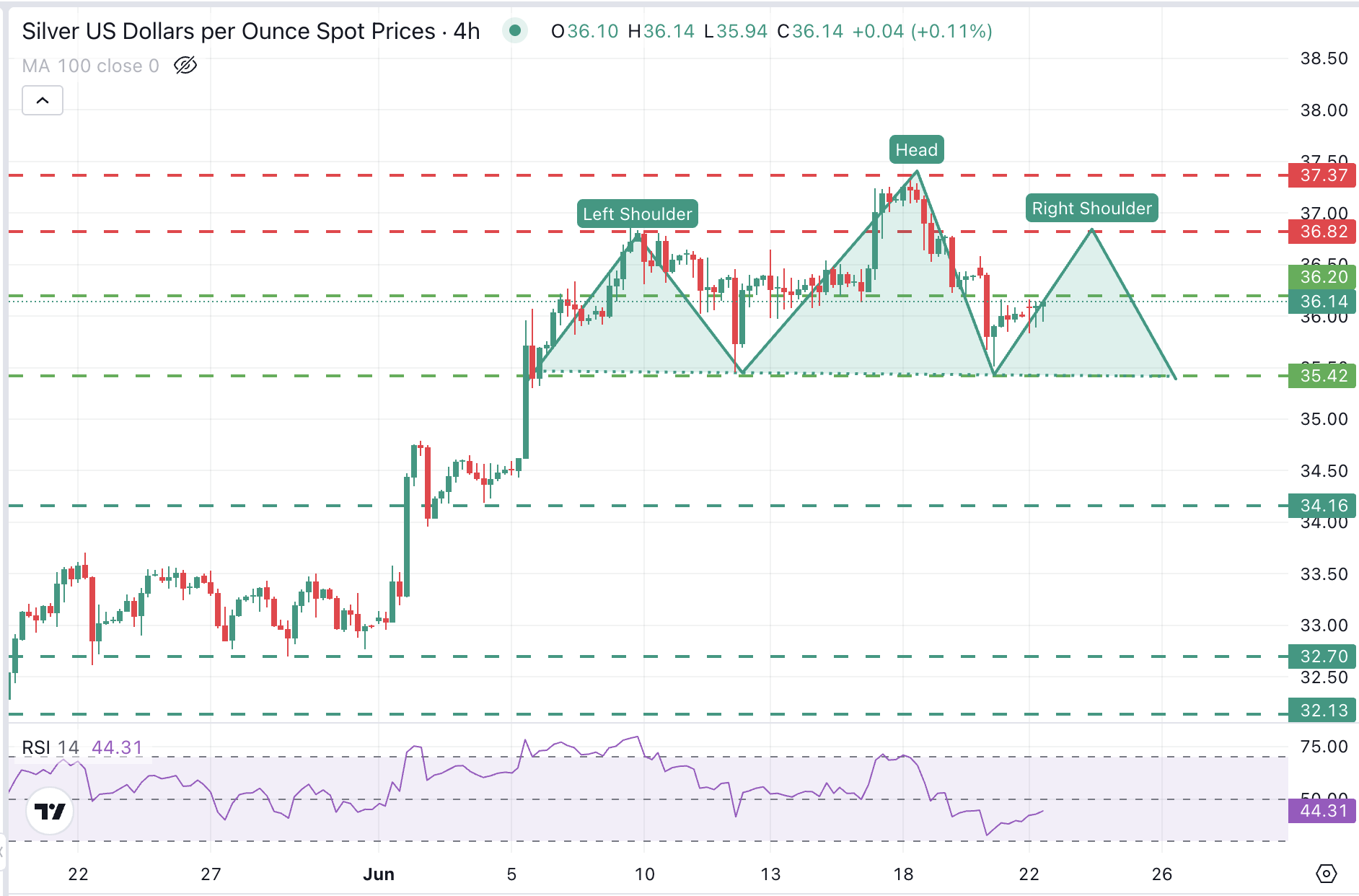Silver Price Forecast: XAG/USD hesitates at $36.00 with risk aversion easing
- Silver found support at $35.50 but seems unable to extend beyond $36.00.
- Risk aversion is easing in the early European session, which is weighing on precious metals.
- XAG/USD is forming a potential bearish H&S with its neckline at $35.45-$35.50,
Silver (XAG/USD) found a bottom near 35.50 following a reversal from multi-year highs at $37.30 last week, but the precious metal is struggling to find significant acceptance above $36.00 on Monday as the risk sentiment improved somewhat at the European session opening.
European bourses have opened with gains, except the UK FTSE100, and Wall Street futures are turning positive, despite ongoing fears about Iran’s retaliation to this weekend’s US attacks.
Iran’s army leaders have vowed severe consequences to the US, but so far, the response to the massive bombings of Iran’s key nuclear sites has been limited to missile strikes on Israel’s soil, sparing US interests in the region. This keeps hopes of avoiding a wider regional war alive for now, which is boosting equities and weighing on safe assets, such as silver.
XAG/USD: Potential Head & Shoulders formation
A view of the 4-hour charts, and we see a frail recovery from Friday’s lows at $35.50. The Relative Strength Index remains well into negative territory, suggesting that the bearish structure of the last three days is still in play, with previous support, at the $36.10 area (June 13, 16, and 17 highs), now acting as resistance.
Above here, the next resistance area is at the June 19 high at $36.82. A rejection here might form a bearish head & Shoulders, a potential topping pattern that would bring the focus back to the key $35.45-$35.50 area, June 12 and 20 lows, and the neckline of the H&S pattern.
A break of that level confirms that the bullish cycle from early May lows is over and that a deeper correction is in progress, with the next bearish targets at $34.10 (June 4 low) and the $32.70 area, which held prices on May 22, 27, 28, and 30.
XAG/USD 4-Hour Chart

Silver FAQs
Silver is a precious metal highly traded among investors. It has been historically used as a store of value and a medium of exchange. Although less popular than Gold, traders may turn to Silver to diversify their investment portfolio, for its intrinsic value or as a potential hedge during high-inflation periods. Investors can buy physical Silver, in coins or in bars, or trade it through vehicles such as Exchange Traded Funds, which track its price on international markets.
Silver prices can move due to a wide range of factors. Geopolitical instability or fears of a deep recession can make Silver price escalate due to its safe-haven status, although to a lesser extent than Gold's. As a yieldless asset, Silver tends to rise with lower interest rates. Its moves also depend on how the US Dollar (USD) behaves as the asset is priced in dollars (XAG/USD). A strong Dollar tends to keep the price of Silver at bay, whereas a weaker Dollar is likely to propel prices up. Other factors such as investment demand, mining supply – Silver is much more abundant than Gold – and recycling rates can also affect prices.
Silver is widely used in industry, particularly in sectors such as electronics or solar energy, as it has one of the highest electric conductivity of all metals – more than Copper and Gold. A surge in demand can increase prices, while a decline tends to lower them. Dynamics in the US, Chinese and Indian economies can also contribute to price swings: for the US and particularly China, their big industrial sectors use Silver in various processes; in India, consumers’ demand for the precious metal for jewellery also plays a key role in setting prices.
Silver prices tend to follow Gold's moves. When Gold prices rise, Silver typically follows suit, as their status as safe-haven assets is similar. The Gold/Silver ratio, which shows the number of ounces of Silver needed to equal the value of one ounce of Gold, may help to determine the relative valuation between both metals. Some investors may consider a high ratio as an indicator that Silver is undervalued, or Gold is overvalued. On the contrary, a low ratio might suggest that Gold is undervalued relative to Silver.
,

